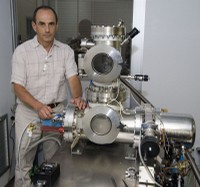[/caption]
A tiny new circuit could make a big difference in the way astronomers can see infrared light. This newly developed nano-sized electronic device is 100 times smaller than the thickness of a human hair, and is sensitive to faint traces of light in the far-infrared spectrum, well beyond the colors humans see. Infrared light makes up 98% of the light emitted since the Big Bang. Better detection methods with this new device should provide insights into the earliest stages of star and galaxy formation almost 14 billion years ago.
“In the expanding universe, the earliest stars move away from us at a speed approaching the speed of light,†said Michael Gershenson, professor of physics at Rutgers and one of the lead investigators. “As a result, their light is strongly red-shifted when it reaches us, appearing infrared.â€
But Earth’s thick atmosphere absorbs far-infrared light, and ground-based radio telescopes cannot detect the very faint light emitted by these far-away stars. So scientists are proposing a new generation of space telescopes to gather this light. But new and better detectors are needed to take the next step in infrared observing.
Currently bolometers are used, which detect infrared and submillimeter waves by measuring the heat generated when photons are absorbed.
“The device we built, which we call a hot-electron nanobolometer, is potentially 100 times more sensitive than existing bolometers,†Gershenson said. “It is also faster to react to the light that hits it.â€
The new device is made of titanium and niobium metals. Its about 500 nanometers long and 100 nanometers wide and was made using techniques similar to those used in computer chip manufacturing. The device operates at very cold temperatures – about 459 degrees below zero Fahrenheit, or one-tenth of one degree above absolute zero on the Kelvin scale.
Photons striking the nanodetector heat electrons in the titanium section, which is thermally isolated from the environment by superconducting niobium leads. By detecting the infinitesimal amount of heat generated in the titanium section, one can measure the light energy absorbed by the detector. The device can detect as little as a single photon of far infrared light.
“With this single detector, we have demonstrated a proof of concept,†said Gershenson. “The final goal is to build and test an array of 100 by 100 photodetectors, which is a very difficult engineering job.â€
Rutgers and the Jet Propulsion Laboratory are working together to build the new infrared detector.
Gershenson expects the detector technology to be useful for exploring the early universe when satellite-based far-infrared telescopes start flying 10 to 20 years from now. “That will make our new technology useful for examining stars and star clusters at the farthest reaches of the universe,†he said.
The team’s orginal paper can be found here.
Original News Source: Rutgers State University


It is truely amazing what our human mind can comprehend, conceive and execute!!
Best Wishes to the team!
Blimey!! Hoe thwe HELL did they get that made, never mind working?
Good luck guys!!
It may be easier to do with using a section of 1000X1000 than 100X100 jla
I follow your posts for a long time and must tell you that your articles always prove to be of a high value and quality for readers.